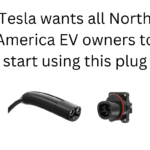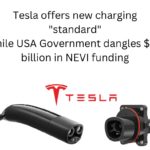Conservative policy think-tank playing loose and fast with the numbers regarding government spending on the Chevy Volt.
Yesterday
the Mackinac Center for Public Policy posted a statement claiming that
each Chevy Volt is subsidized to the tune of $250,000 or more. That’s
caused a cluster of blog posts trumpeting this as if it’s a failure of
the Obama administrations green technology program, but not so fast says
an article on TheStreet. Instead the Mackinac Center’s analysis is
overly simplistic and downright absurd.
The Mackinac Center’s James Hohman identifies a $3 billion figure as
the total amount of “subsidy” going to GM and other companies to produce
the Chevy Volt. What they’re calling “subsidies” are the loans and
grants awarded to GM, and several other companies, by the Federal
government and several local governments. Some of the awards went to GM
for the factories directly used to build the Volt, and some to other
companies building factories for electric car battery packs and other
parts. For example Compact Power Inc, the U.S. subsidiary of Korean
battery manufacturer LG Chem, received a grant to help them build the
factory which manufactures the battery cells used on the Volt. GM’s
assembled the battery packs in their own factory, with Compact Power
only supplying the cells. The extent of the Mackinac Center analysis is
to name the $3 billion figure derived from adding up the total figure
for all grants and loans they could find, then divide by the 6000 Volt’s
that have been sold.
An article on TheStreet.com, after quibbling a bit over the $3
billion total, says it simply doesn’t matter what the total grants and
loans package is. The quibble is that $3 billion divided by 6000 is
$500,000 per car, not the $250,000 per car they cite, making us wonder
about Hohman’s abilities with basic math. The flaw in Hohman’s
analysis, says TheStreet, is to divide by the 6000 Volts that have been
sold, rather than the total number of vehicles which will be built in
these factories. The grants and loans Hohman points to were for
factories that will be operating for many years, some of which will be
building components used by multiple manufacturers. For example the
Compact Power (LG Chem) plant mentioned earlier manufactures cells not
just for the Chevy Volt, but for Ford’s electrified vehicles such as the
Ford Focus Electric. It would be incorrect to assign the grant for LG
Chem’s plant solely to the Volt, as Hohman’s analysis does.
What’s the typical lifespan of a factory? Would these factories
built by grants and loans recipients be used only for one year then torn
down? That false line of reasoning is what Hohman’s analysis suggests.
Instead, the TheStreet article suggests considering this as an
investment over a 25 year lifespan. How many electrified cars will be
built over the next 25 years?
As is typical in every industry the cost to develop technology and
production facilities for every product is covered not by the first unit
sold, or the first 6000 units sold, but over the lifetime of that
product. The absurd analysis by Hohman would have given even more
alarming numbers if they’d thought to publish their piece 6 months ago
when only 3000 Volt’s had been sold, at which time the “subsidy per car”
at that time would have been $500,000. Going the other direction, pick
an arbitrary day in the future like the end of March 2012. GM will
plausibly have sold another 10,000 more Volt’s by then, bringing total
sales to 16,000 Volt’s, and the subsidy per Volt will have dropped to
$94000. If GM is successful with their sales goals, total Volt sales at
the end of 2012 will be 66,000, dropping the subsidy per Volt to
$23000. And that isn’t even counting the electrified vehicles Ford will
have sold in the same time frame, also using cells manufactured from
the same LG Chem plant, the cost for which Hohman wants us to assign
solely to GM’s Chevy Volt.
The article on TheStreet doesn’t stop there, it addresses another
myth about the Volt, namely those who derisively call the Chevy Volt
Obama’s brainchild. Anybody with any memory for recent history knows
that GM’s then-CEO, Bob Lutz, started pushing for the Volt in 2006 and
that the majority of design decisions had been made by late 2008,
including the selection of LG Chem to supply the battery cells. The
production version of the Volt was unveiled in September 2008, with
actual production slated for November 2010. The Volt was already in the
pipeline by the time the Obama Administration was elected, and most
notably before GM’s bankruptcy.
Anton Wahlman, the author of the TheStreet article, describes himself
as a conservative commentator “somewhere to the right of Rush Limbaugh
on the subject of Government involvement in the economy”. While he is
rather opposed to this sort of Government spending, he describes this
particular case as an example of absurd reasoning and calls the Volt as
an “outstanding car” that may be “the best car in the market today”.
There are factors here that even Wahlman’s excellent
analysis does not note. There is a bigger picture than just one car,
and a few factories.
First, the push for cleaner cars started years before Obama came to
office. The Bush Administration did a fair bit in this direction
including the Advanced Technology Vehicles Manufacturing Loan Program,
which is still a source of clean vehicle technology funding.
Second, the batteries being produced by LG Chem, A123, EnerDel and
other companies are not just going to electrified vehicles. There’s a
huge market opening up for grid-scale energy storage systems, and the
battery companies are all developing products for that market in
addition to electrified vehicles.
Third, is the Sputnik Moment meme the Obama Administration has talked
about for a couple years. There is a race underway to develop clean
technology, and the U.S. runs the risk of being left in the dust. Do we
want to wean ourselves from a dependence on foreign oil to only develop
a dependence on foreign batteries?
Any way you slice it, the analysis pushed by the Mackinac Center is weak and misleading.
See:
Setting it Straight: Chevy Volt vs the Government![]()
Originally published at TorqueNews: http://www.torquenews.com/1075/250k-chevy-volt-subsidy-claim-bogus-says-thestreetcom![]()
- Highway design could decrease death and injury risk, if “we” chose smarter designs - March 28, 2015
- GM really did trademark “range anxiety”, only later to abandon that mark - March 25, 2015
- US Government releases new regulations on hydraulic fracturing, that some call “toothless” - March 20, 2015
- Tesla Motors magic pill to solve range anxiety doesn’t quite instill range confidence - March 19, 2015
- Update on Galena IL oil train – 21 cars involved, which were the supposedly safer CP1232 design - March 7, 2015
- Another oil bomb train – why are they shipping crude oil by train? – Symptoms of fossil fuel addiction - March 6, 2015
- Chevron relinquishes fracking in Romania, as part of broader pull-out from Eastern European fracking operations - February 22, 2015
- Answer anti- electric car articles with truth and pride – truth outshines all distortions - February 19, 2015
- Apple taking big risk on developing a car? Please, Apple, don’t go there! - February 16, 2015
- Toyota, Nissan, Honda working on Japanese fuel cell infrastructure for Japanese government - February 12, 2015














